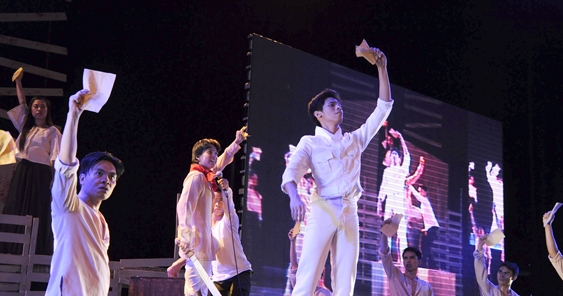Paul Alexander Morales, artistic director of Ballet Philippines, filmmaker, playwright, and exponent of inter-disciplinary theater performances that necessitate the collaboration of ballet dancers, singers, rock bands, actors, and sculptors, gives a personal perspective into how contemporary dance has been shaped by evolving video technology.
Words by Paul Alexander Morales; Photo Courtesy of Ballet Philippines
Dance emanates light. From its beginnings in rituals and religious ceremonies dancers have exuded energy and patterns etched into the vision of their witnesses—carved by sunlight, moonlight, camp fire and the dancing body. Dancing is the willingness to become light.
Like our impressions of stars and other celestial bodies our experience of dance, as an audience, is essentially one of vision, an experience of seeing. The moving image and the wizardry of capturing light on film mimics our own mind’s eye and memory. Edward Muybridge’s ground breaking sequential still photographs gave us a new understanding of motion and its dynamics. Modern techniques amplify our vision even more, allowing us to quicken or slow action, repeat, manipulate and edit to create new effects. From giant screens to television, today we carry our moving images with us in our intimate personal devices.

For the last eight years, I had the privilege and challenge to develop dance works for Ballet Philippines at the Cultural Center of the Philippines’ Main Theater (Tanghalang Nicanor Abelardo), our country’s best stage for dance. Walking into the space on any other day aside from the performances one would find the cavernous emptiness of possibility and the experiential dissonance of the many distinct activities that add up to a production for public consumption. Expectedly we would find the tailors and costume mistresses doing last minute adjustments and plotting changes. The set and lights crew would be going through their own to do list. We would witness the many cast members preparing and practicing for their parts – a jumble of impressions and activities born out of tradition and necessity. Today our modern technologies have opened up new possibilities and practices that inform our contemporary world of dance. Video projection has joined our list of theatrical tools serving as set, special effect or even was character in performances. They come with their own process, challenges and rewards.
Before film or photos were part of a process of delayed gratification. Now video and photos, with its accessibility has become an integral part of the dance world. We learn dances from videos and dancers and dance makers rely on its godlike power of instant recall to allow us to examine, remember and also share the dance. With the advent of social media and social marketing it is now common to find snippets of the whole creation process online. As producers in a modern world we use the tools and platforms in cyberspace to give our audiences an unprecedented intimate, on demand space. Onstage video technologies have opened up new vistas and modern looks for the theatre. Online we have access to a whole history of dance and the dynamic history that is unfolding.
From the initial experiments with slides, overhead projectors or the smattering of film and televisions on stage – perhaps the most seminal work that heralded multimedia dance in the Philippines would be the extensive and intense collaboration of conceptual video maker Tad Ermitano and choreographer Denisa Reyes for “Undress the Icon” (Ballet Philippines, 1997). Later, Tad would also stun with his conceptual delayed video interaction device that premiered at the Wi-Fi body festival at the CCP in 2010. Notable also were the interactions with filmmakers Mark Gary, Butch Perez and Carlitos Siguion for Reyes’ Neo-Filipino in 2000. Outside the CCP companies like Airdance, Myra Beltran Dance Forum and Ballet Manila have also used these technologies. At the CCP the Philippine Ballet Theater has also used extensive video effects in their productions, for example in their recent “Darangen ni Bantugen” revived in 2016.
In our reworking of Alice Reyes’ “Tales of the Manuvu” (2009) live cameras added to the experienced performance. Collaborations with Digibox Video Productions using the dedicated dance technology software Isadora ™ include the magical effects for Carlo Pacis’ “Midsummer Night’s Dream” (2013) the Brechtian effects in “Rock Supremo” (2013) and aided the mutant superpowers in “Manhid” the superhero musical (2015). Collaborating with filmmaker Ruelo Lozendo on our Rizal adaptations “Crisostomo Ibarra” (2010) and “Simoun” (2016) cinematic vignettes were juxtaposed with the post modern narrative action happening on stage. GA Fallarme’s projection schemes would illuminate the stage settings of our recent works including “Awitin Mo at Isasayaw Ko” and Swan Lake while Film Pabrika shot stunning material for Gabriel Barredo’s “Opera” (all in 2016-2017).
Video and its expanding parameters have truly become part of our process for dance. From documentation for rehearsal and in performance. From producing viral materials even expanding into full length documentaries or films. From text and graphics to live settings and effects that interact with the action onstage.
Our dancers of light continue to present challenging propositions for our enjoyment. Sampled best live or on various formats and sizes, the ever flickering reflection of light on the human body.







